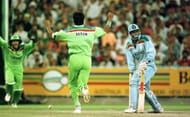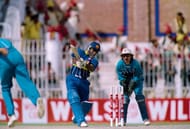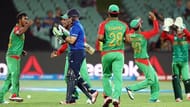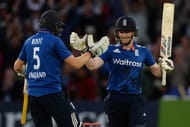The Game of Cricket has been in existence since the 16th century. It was born in southern England and ended up becoming the national sport of the country in the 18th century.
Owing the expansion of British empire, the game of Cricket made its way into all the countries which were ruled by them. The first international cricket match took place in 1844 when the United States played host to Canada while the first international test match was officially played on March 15th, 1877 between Australia and England at Melbourne.
Nearly a century later in 1975, The ‘International Cricket Council’, which is the governing body of the sport, organised its very first limited overs Cricket World Cup. Till date, a total of eleven Cricket World Cups have been organised and Team England has not won even single one so far.
It is quite ironical that a country which gave birth to the sport does not have a World Cup trophy to their credit. This fact has been a tough one to digest for the cricket aficionados.
The rules and format of limited-overs cricket have undergone many changes over the years and each international team is expected to adapt to these modifications. Team England were unable to adapt as well as their counterparts since after the fifth ICC World Cup in 1992 and have struggled to claim a spot in the semi-finals of any edition of the tournament till date.
This shows how low the England performance has stooped to at the biggest stage of the limited overs format of cricket.
1975 – 1993
The excuse for their inability to deliver at the most prestigious tournament of ICC cannot be that they had an inferior team as compared to the other international teams at that time. This can be authenticated by their ODI rankings from the period of January 1981 to March 1993, where they held the top position for an impressive 29 months.
This feat cannot be achieved sans a quality, well balanced and talented team of players. In fact, it can be observed that they managed a semi-final spot in every World Cup during this phase.
In addition, the first three World-Cups were hosted by England, which was a considerable advantage as they were familiar with the home conditions. Despite having so many factors tilt in their favour, the much desired ‘Cup’ remained out of their grasp.
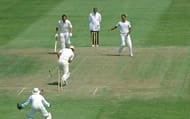
In the first World Cup of 1975, Team England dominated in all the matches until they faced Australia in the semi-final, where their batting order collapsed and got bundled out for 93 runs.
England bettered its performance in the following tournament and earned a spot in the finals of the 1979 World Cup, where they faced one of the giants of cricket – West Indies. This time around, Vivian Richard’s 138* set up a chase of 287 in 60 overs for England, which was considered to be a very big chase back then.
England gave into the pressure of the required run-rate and were wrapped up for 194.
Then came the 1983 World Cup where Team India outplayed every opposition that was presented to them. England faced India in the semi-final where they could offer no resistance of any sorts as India cruised into the finals, eventually going on to win the tournament as well.
The first World Cup tournament to be played outside England was the fourth edition in 1987, where India and Pakistan were the hosts. Team England, led by wicketkeeper-batsman Mike Gatting, came out victorious this time against India in the semifinals to set up a clash against Australians in the final.
As England chased 254 to win, they were restricted to 246/8 by the Aussies. This is the closest the English players have ever come to winning the World Cup trophy, as they fell short by a mere 7 runs.
Then came the 1992 World Cup, where Imran Khan came out of retirement and guided his team to a maiden World Cup victory. England got a final spot in this edition as they had passed the South African challenge in the semifinal courtesy a flawed Duckworth-Lewis method that was imposed on the match due to rains.
In the finals, England were outright favourites to win their first trophy as prior in the tournament, they had bowled out the Pakistan’s batting order for an embarrassing score of 74. England had to chase 250 in 50 overs which was a gettable score, but a somewhat challenging one.
However, the pace attack of Pakistan swung the leather ball both ways and with the help of leggie Mushtaq Ahmed, England were bowled out for 229.
Not many had expected this outcome of the 1992 final. England missed out on another golden opportunity to grab the ever evasive World Cup.
1993 – Present
Ever since 1993, Team England has struggled to get a hold of the numero uno position in the ICC ODI rankings as they have held the top position for just 7 months since 1993. Now this is a striking contrast when compared to their previous years’ record.
Team Englands progress at World Cup matches has gone downhill in this phase as well. From the 1996 World Cup onwards, not a single team from England has experienced what it’s like to play in the semi-final of this historic tournament.
The One Day International format of cricket has undergone quite a few rule changes over the years in order to make it more appealing and interesting to the spectators. The fielding restrictions rule is one that has been changed many times by the ICC for the benefit of the game.
For example, in 1980-81, fielding restrictions were imposed for the first time. In these restrictions, two fielders were allowed outside the inner circle for first 15 overs and five fielders after the 15th over.
The next change came directly in 2005, stating that only two fielders were allowed outside the 30 yards circle for first 10 overs. Two powerplays of 5 overs each were also finalised, with the bowling side having the discretion over the timing of both.
The latest rule change states that 5 fielders shall be allowed outside the 30-yard circle in the last 10 overs, which was 4 fielders initially.
Apart from the aforementioned rules, a new revolutionary cricket format was introduced in 2004 called Twenty20, where each team gets to bat for just 20 overs. In this format of the game, the powerplay lasts until the 6th over and only 2 fielders are allowed outside the inner circle during this period.
This format not only gave cricket its fastest and most spectacular version of the game, but also gave the players the opportunity to resort to gameplays that are risky but highly rewarding in terms of effectiveness.
Each department of the game namely bowling, batting and fielding witnessed exceptional changes and modification. The game of cricket had advanced multiple folds and T20 format deserves every bit of applause for making it happen.
With so many developments happening in cricket since 1993, the cricket team that adapted sooner to such developments was at an advantage over their competition.
Team England probably fell prey to not being able to alter their gameplay as effectively as others did and were often criticised for their orthodox style of cricket. Alec Stewart, a former wicketkeeper-batsman for England, gave a public statement in 2014 condemning England for playing ‘boring and embarrassing cricket’.
“We are playing one day cricket as if it is still 1995. We need a change of mindset, game plan and culture”
Alec did have a valid point regardless of how bitter his statement was. England have always followed ‘textbook’ cricket for a very long time but it did not help their cause when ICC introduced the changes in the rules of the ‘Gentlemen’s game’.
Another valid point for England’s boring cricket style could be the number of test matches they play each year. Due to this, the team plays conservative cricket most of the time and also ends up picking up physical as well as mental fatigue in the long run.
To add to the woes of English cricket, the exceptionally talented Kevin Pietersen was sacked by English Cricket Board due to a rift between him and the team management. Owing to mysterious reasons, one of the best players England had ever seen was compelled to cut his international career abruptly.
In February 2014, Pieterson was not selected for the Caribbean tour and that turned out to be the end of his career as he gave a public statement stating the same.
The incidents mentioned above, when considered cumulatively, gives a clear picture about how the England team have been marred by instances that have lead to their poor display in cricket post-1993.
The England Cricket Board and the cricket team both need to work in unison towards achieving the dream that they have been pursuing from the day their ancestors stepped onto the field in the first match of the first World Cup on 7th June 1975 against India, which is to win cricket’s premier international tournament.
Positive Signs
On the positive side, the England team is inching towards becoming a force to reckon with in time for the next World Cup in 2019, which they will proudly host along with Wales. Efforts are definitely being made in the right direction by ECB and English players as the results of the New Zealand’s tour of England in 2015 suggest.
In that series, England displayed no signs of orthodox cricket as the new recruits reinvented the team’s style of batting and bowling against a world-class New Zealand side, who had just finished the 2015 World Cup as runners up.
The team totals accumulated by English batters in the 5 ODI Series against New Zealand were 408, 365, 302, 350 and 192 respectively. Add to that the 191 in the lone T20 match-up between the two teams and this definitely becomes the best run-scoring form in the history of English cricket.
The inventors of cricket are gradually realising their full potential as they prepare for the next World-Cup in 2019 and needless to say, it will be an opportunity worth grabbing since they play at home and have a few years to prepare for the tournament.
Unless any other international team plays exceptionally well, we could probably witness English players lifting the 2019 World Cup in the cool and overcast conditions of England.
Brand-new app in a brand-new avatar! Download Cric Rocket for fast cricket scores, rocket flicks, super notifications and much more!
